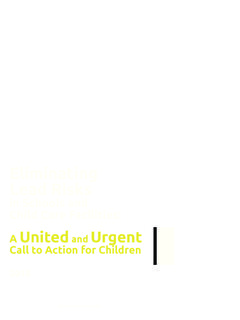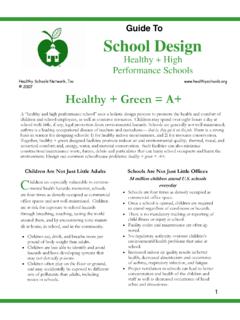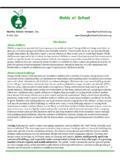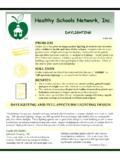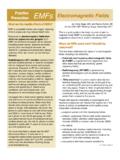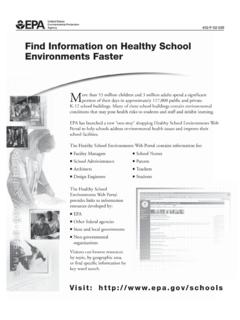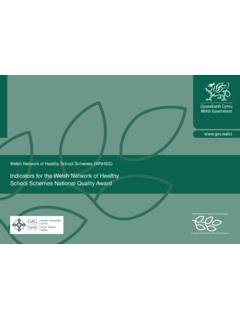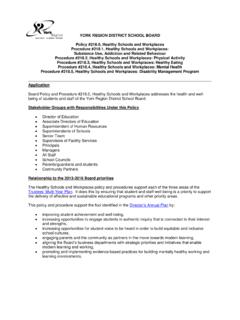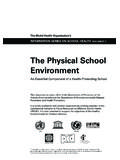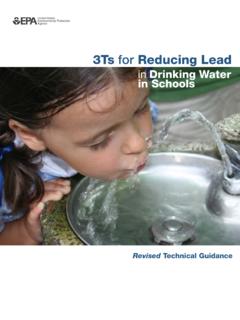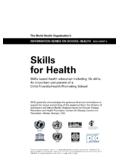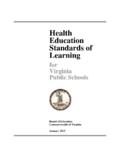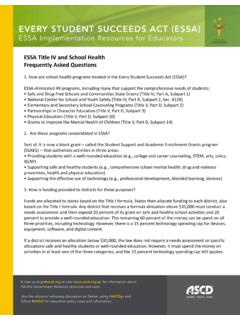Transcription of School Renovation and Construction: What you …
1 1 Hazards to Children During Renovation and construction Schools must provide a healthful, safe learning environment which promotes attendance and achievement. construction and Renovation projects conducted while School is in session severely test this responsibility and often present unnecessary risks to children and staff. Some environmental hazards that can occur during School Renovation and construction include: Lead-contaminated debris Asbestos fibers and fiber glass Wood, sheet rock, cement dust, and dust contaminated with lead/asbestos/molds Fumes from construction equipment (diesel fuel from heavy machinery) Fumes from toxic products (paints, sealers, glues, varnishes or urethanes, roofing tar) Excessive, loud noises Fumes from new furnishings and equipment (copiers, carpets, new particle board or plywood) Specifically, these materials can include materials which are known to harmful to human health, including children s health.
2 Volatile Organic Compounds (VOCs) (glues, paints, floor finishes, other construction materials) Polybrominated Diphenyl Ethers (PBDEs) (materials with halogenated flame retardants, including foams and finishes) Polyvinyl chloride (PVCs) plastics (flooring, plumbing, wall coverings and partitions) Polychlorinated biphenyls (PCBs) (caulk and fluorescent light ballasts, typically in older buildings constructed or renovated from the 1950 s through 1978) Lead (paint in schools constructed or renovated before 1978, soil); the US Environmental Protection Agency enforces the Renovation , Repair and Painting (RRP) Rule, which requires that contractors be certified in lead-safe work practices before renovating, repairing or painting schools, daycares or homes where lead paint will be disturbed.
3 Contractors are also required to take steps to minimize the exposure of occupants to lead-contaminated dust by containing the work area, using methods that produce the least amount of dust, and thoroughly cleaning the area after the work is finished Mold (ceiling tiles, drywall, carpets, carpet pads and other building materials) School occupants at higher risk for health problems include all children, pregnant women and those with chronic illnesses or impaired immune systems. (Sources: Institute of Medicine, Climate Change, the Indoor Environment, and Health; Healthy Building Network; Collaborative on Health and the Environment, Learning and Developmental Disabilities Institute; US Environmental Protection Agency, Mold Remediation in Schools and Commercial Buildings, PCBs in Caulk in Older Buildings, and Renovate Right: Important Lead Hazard Information for Families, Child Care Providers, and Schools) School Renovation and construction : What you Need to Know to Protect Child and Adult Environmental Health Healthy Schools Network, Inc.
4 2000, 2012 2 This guide details the New York State regulations schools must follow during Renovation and construction to protect children and adults from hazards. Parents or others who care about the health and safety of children must be informed about the law and vigilant about its implementation. Children s Health is Affected by Their Environment Why you Need to Pay Attention! Children s health is uniquely affected by the environment. Today, children are growing up with complex toxic environmental threats to health ranging from asthma-inducing air pollution to toxic chemicals. Children are not just little adults and are especially vulnerable to environmental risks because: Their bodies are still developing They proportionately eat, drink and breathe more per pound of weight than adults They are exposed to more environmental threats They are less able to identify or protect themselves from exposures to environmental hazards There is growing evidence that contaminated indoor air can produce verbal, perceptual, motor and behavioral disabilities in children.
5 It can also cause hearing impairments, irritability and developmental delays. Children who are asthmatic, allergic, chemically sensitive or are health-impaired may need special protection to promote optimal health and learning. Children may be in School up to 10 hours a day, and they outnumber adults in School settings. Schools are, on average, four times more densely occupied than office spaces. No School is required to report pupil illness or injury. Schools are not required to hire School nurses. (Sources: American Academy of Pediatrics Council of Environmental Health, Pediatric Environmental Health, 3rd Ed.; US Environmental Protection Agency, IAQ Tools for Schools) The Rights of Children and Parents to Healthy, Safe Schools Every child has a right to an environmentally safe and healthy learning environment that is clean and in good repair.
6 Schools should serve as role models for environmentally responsible behavior. Every child, parent and School employee has a right-to-know about environmental health issues and hazards in their School environment. School officials and appropriate public agencies should be held accountable for environmentally safe and healthy School facilities. Schools should serve as role models for environmentally responsible behavior. Federal, state, local and private sector entities should work together to ensure that resources are used effectively and efficiently to address environmental health and safety conditions. (Source: Guiding Principles for Improving the Environmental Quality of Schools, adopted by New York State Board of Regents, 1994) New York State Laws on School Renovation and construction In 1999, New York State adopted new regulations known as the Comprehensive Public School Safety Program.
7 Within these regulations, the Uniform Safety Standards provide some health protection for children and other School building occupants during Renovation and construction . The Board of Education of each School district, including New York City, and each Board of Cooperative Educational Services (BOCES) is required to ensure that all School building-level Renovation and construction plans, specifications, or other work in occupied facilities complies with health and safety procedures. The checklist on the next page provides a specific list of actions that must be taken in schools. (Source: Comprehensive Public School Safety Program, Part 155 Regulations, New York State Education Department, February 2010) 3 Comprehensive Public School Safety Program: CHECKLIST of Uniform Safety Standards During Renovation and construction (Source: Comprehensive Public School Safety Program, Part 155 Regulations, New York State Education Department, February 2010) Pre- construction notification of parents, staff, and the community two months in advance of a construction project of $10,000 or more to be conducted while School building is occupied.
8 If the project is an emergency, notice must be provided as soon as practicable. Notice may be met by publication in district newsletters, direct mailings, or holding a public hearing on the project. Pre- construction testing and planning so that safety is addressed in bid specifications; all areas to be disturbed during Renovation or demolition must be tested for lead and asbestos and procedures to protect occupant health must be included in the final construction documents for bidding. Monitoring of construction and maintenance activities for compliance with minimum requirements of a certificate of occupancy and to ensure there are no safety violations. (Investigations and response to complaints related to health and safety as a result of construction and maintenance activities.)
9 Health and Safety (H&S) Committees, which include representatives from district officials, staff, bargaining units and parents must be created in every School district. Procedures must be established for involvement of the H&S Committee to monitor construction to include the project architect, construction manager, and the contractors. In large cities (one million or more), procedure for protecting health and safety during construction must be submitted to the Commissioner of Education for approval. The H&S Committee must also be involved in the investigation and response to complaints. The District Emergency Plan must be updated to accommodate the construction process, including an updated emergency exit plan, with, if necessary, temporary exits.
10 Provisions must be made for an emergency evacuation and relocation or release of students and staff in the event of a construction incident Fire drills must be held to familiarize students and staff with temporary exits and revised emergency exits. General safety and security standards, including: construction materials must be stored in a safe and secure manner; Fences must be maintained around supplies and debris; Gates must be locked unless a worker is in attendance to prevent unauthorized entry; Overhead protection and warning signs must be provided; Workers must wear identification badges. Separation of construction areas from occupied spaces must occur for those construction areas under the control of a contractor. Provisions must be made to prevent the passage of dust and contaminants into occupied parts of the building and periodic inspections must be made to prevent exposures to these materials.
